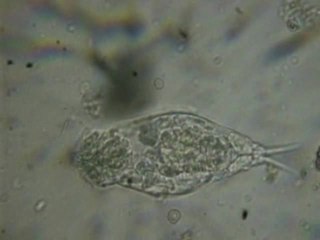
The rotifers, commonly called wheel animals or wheel animalcules, make up a phylum of microscopic and near-microscopic pseudocoelomate animals.

Monogononta is a class of rotifers, found mostly in freshwater but also in soil and marine environments. They include both free-swimming and sessile forms. Monogononts generally have a reduced corona, and each individual has a single gonad, which gives the group its name. Males are generally smaller than females, and are produced only during certain times of the year, with females otherwise reproducing through parthenogenesis.
Seisonidae is a family of rotifers, found on the gills of Nebalia, a marine crustacean. Peculiar among rotifers, males and females are both present and equal in size. Males and females are similar with paired gonads. It is considered to have diverged from the other rotifers early on, and in one treatment is placed in a separate class Seisonoidea. They have a large and elongate body with reduced corona. Their muscular system is similar to that of other rotifers: they have longitudinal muscles as well as open annular muscles.

Brachionus calyciflorus is a planktonic rotifer species occurring in freshwater. It is commonly used as a model organism in toxicology, ecology and evolutionary biology.
Its advantages include the small size and short generation time.

Keratella cochlearis is a rotifer. The planktonic animal occurs worldwide in freshwater and marine habitats.

Ploima is an order of rotifers, microscopic invertebrates found in marine and freshwater habitats.
Adineta ricciae is a species of freshwater rotifers in the family Adinetidae. It was first described in 2005 after being discovered by chance in dry mud beside a billabong in Australia. It is used as a model organism as it is easy to keep in culture.
Brachionus nilsoni is a euryhaline rotifer in the family Brachionidae. The species is distinguishable from all brachionids by lacking posterior spines, by the shape of the foot apertures and the posterior portion of its lorica, and the long thin occipital spines. It is named after Börje Carlin-Nilsson.

Cephalodella is a genus of rotifers in the family Notommatidae.
Trichocerca is a genus of rotifers belonging to the family Trichocercidae.
Scaridium is a genus of rotifers belonging to the family Scaridiidae.
Platyias is a genus of rotifers belonging to the family Brachionidae.

Lecane is a genus of rotifers belonging to the family Lecanidae. It is the only genus in the monotypic family Lecanidae and has a cosmopolitan distribution

Lepadella is a genus of rotifers belonging to the family Lepadellidae. The genus has a cosmopolitan distribution

Euchlanis is a genus of rotifers belonging to the family Euchlanidae.

Colurella is a genus of rotifers belonging to the family Lepadellidae. The genus has a cosmopolitan distribution
Dipleuchlanis is a genus of rotifers belonging to the family Euchlanidae.
Flosculariidae is a family of rotifers belonging to the order Flosculariaceae.
Floscularia is a genus of rotifers belonging to the family Flosculariidae.
Brachionus forficula is a species of freshwater rotifer in the family Brachionidae.









